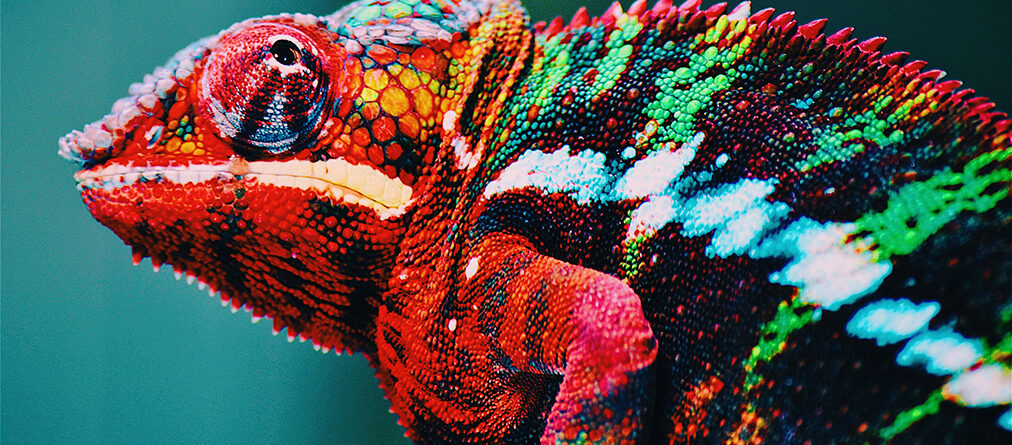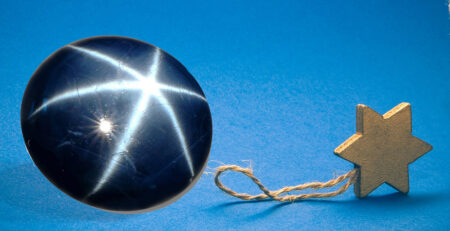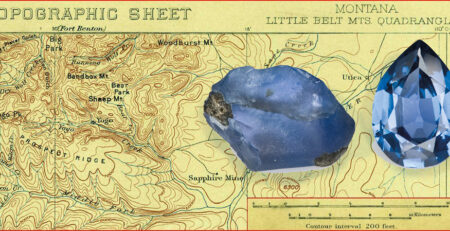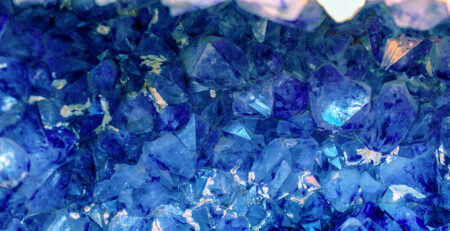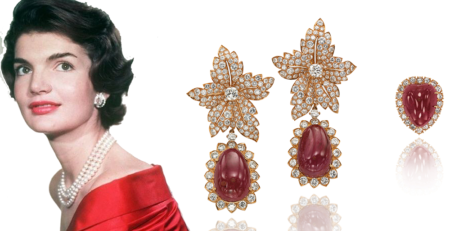Corundum’s Chameleons— Color-change Sapphires
A rare variety of natural sapphire, known as color-change sapphire, exhibits different colors in different light. Color change sapphires are blue in outdoor light and purple under incandescent indoor light, or green to gray-green in daylight and pink to reddish-violet in incandescent light.
Color change sapphires come from a variety of locations, including Madagascar, Myanmar, Sri Lanka and Tanzania. Two types exist. The first features the chromium chromophore that creates the red color of ruby, combined with the iron + titanium chromophore that produces the blue color in sapphire. A more rare type, which comes from the Mogok area of Myanmar, features a vanadium chromophore, the same as is used in Verneuil synthetic color-change sapphire.Virtually all gemstones that show the “alexandrite effect” show similar absorption/transmission features in the visible spectrum. This is an absorption band in the yellow (~590 nm), along with valleys of transmission in the blue-green and red. Thus the color one sees depends on the spectral composition of the light source. Daylight is relatively balanced in its spectral power distribution (SPD) and since the human eye is most sensitive to green light, the balance is tipped to the green side. However incandescent light (including candle light) is heavily tilted to the red end of the spectrum, thus tipping the balance to red.
Color-change sapphires colored by the Cr + Fe/Ti chromophores generally change from blue or violetish blue to violet or purple. Those colored by the V chromophore can show a more pronounced change, moving from blue-green to purple.
Certain synthetic color-change sapphires have a similar color change to the natural gemstone alexandrite and they are sometimes marketed as “alexandrium” or “synthetic alexandrite”. However, the latter term is a misnomer: synthetic color-change sapphires are, technically, not synthetic alexandrites but rather alexandrite simulants. This is because genuine alexandrite is a variety of chrysoberyl: not sapphire, but an entirely different mineral.
Rubies are corundum with a dominant red body color. This is generally caused by traces of chromium (Cr3+) substituting for the (Al3+) ion in the corundum structure. The color can be modified by both iron and trapped hole color centers.
Unlike localized (“intra-atomic”) absorption of light which causes color for chromium and vanadium impurities, blue color in sapphires comes from intervalence charge transfer, which is the transfer of an electron from one transition-metal ion to another via the conduction or valence band. The iron can take the form Fe2+ or Fe3+, while titanium generally takes the form Ti4+. If Fe2+ and Ti4+ ions are substituted for Al3+, localized areas of charge imbalance are created. An electron transfer from Fe2+ and Ti4+ can cause a change in the valence state of both. Because of the valence change there is a specific change in energy for the electron, and electromagnetic energy is absorbed. The wavelength of the energy absorbed corresponds to yellow light. When this light is subtracted from incident white light, the complementary color blue results. Sometimes when atomic spacing is different in different directions there is resulting blue-green dichroism.

Purple sapphires contain trace amounts of chromium and iron plus titanium and come in a variety of shades. Corundum that contains extremely low levels of chromophores is near colorless. Completely colorless corundum generally does not exist in nature. If trace amounts of iron are present, a very pale yellow to green color may be seen. However, if both titanium and iron impurities are present together, and in the correct valence states, the result is a blue color.
Intervalence charge transfer is a process that produces a strong colored appearance at a low percentage of impurity. While at least 1% chromium must be present in corundum before the deep red ruby color is seen, sapphire blue is apparent with the presence of only 0.01% of titanium and iron.
Related posts
- The Timeless Jacqueline Kennedy Onassis Jewelry Collection
- Reimagine these 10 famous jewellery pieces with our natural blue sapphires
- The Natural Wonder of Star Sapphires
- Elizabeth Taylor’s Impressive Jewelry Collection
- The Word’s Five Most Famous Blue Sapphires
- Most famous Ceylon blue Sapphire ring
- The Natural Rough Yellow Sapphire
- Melania Trump: The First Lady’s Jewelry Collection
- Kate Middleton’s Stunning Jewellery Collection
- Yogo Sapphires : The ‘Blue Pebbles’ of Montana
- Sapphire Mining



